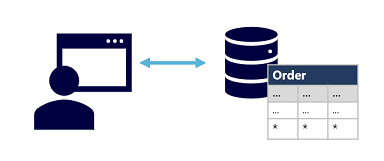A transactional data processing system is what most people consider the primary function of business computing. A transactional system records transactions that encapsulate specific events that the organization wants to track. A transaction could be financial, such as the movement of money between accounts in a banking system, or it might be part of a retail system, tracking payments for goods and services from customers. Think of a transaction as a small, discrete, unit of work.
Transactional systems are often high-volume, sometimes handling many millions of transactions in a single day. The data being processed has to be accessible very quickly. The work performed by transactional systems is often referred to as Online Transactional Processing (OLTP).

OLTP solutions rely on a database system in which data storage is optimized for both read and write operations in order to support transactional workloads in which data records are created, retrieved, updated, and deleted (often referred to as CRUD operations).
OLTP systems enforce transactions that support so-called ACID semantics:
- Atomicity – each transaction is treated as a single unit, which succeeds completely or fails completely. For example, a transaction that involved debiting funds from one account and crediting the same amount to another account must complete both actions. If either action can't be completed, then the other action must fail.
- Consistency – transactions can only take the data in the database from one valid state to another. To continue the debit and credit example above, the completed state of the transaction must reflect the transfer of funds from one account to the other.
- Isolation – concurrent transactions cannot interfere with one another, and must result in a consistent database state. For example, while the transaction to transfer funds from one account to another is in-process, another transaction that checks the balance of these accounts must return consistent results - the balance-checking transaction can't retrieve a value for one account that reflects the balance before the transfer, and a value for the other account that reflects the balance after the transfer.
- Durability – when a transaction has been committed, it will remain committed. After the account transfer transaction has completed, the revised account balances are persisted so that even if the database system were to be switched off, the committed transaction would be reflected when it is switched on again.
analytical data processing
- Data files may be stored in a central data lake for analysis.
- An extract, transform, and load (ETL) process copies data from files and OLTP databases into a data warehouse that is optimized for read activity. Commonly, a data warehouse schema is based on fact tables that contain numeric values you want to analyze (for example, sales amounts), with related dimension tables that represent the entities by which you want to measure them (for example, customer or product),
- Data in the data warehouse may be aggregated and loaded into an online analytical processing (OLAP) model, or cube. Aggregated numeric values (measures) from fact tables are calculated for intersections of dimensions from dimension tables. For example, sales revenue might be totaled by date, customer, and product.
- The data in the data lake, data warehouse, and analytical model can be queried to produce reports, visualizations, and dashboards.Data lakes are common in large-scale data analytical processing scenarios, where a large volume of file-based data must be collected and analyzed
Different types of user might perform data analytical work at different stages of the overall architecture. For example:
- Data scientists might work directly with data files in a data lake to explore and model data.
- Data Analysts might query tables directly in the data warehouse to produce complex reports and visualizations.
- Business users might consume pre-aggregated data in an analytical model in the form of reports or dashboards.
An OLAP model is an aggregated type of data storage that is optimized for analytical workloads. Data aggregations are across dimensions at different levels, enabling you to drill up/down to view aggregations at multiple hierarchical levels; for example to find total sales by region, by city, or for an individual address. Because OLAP data is pre-aggregated, queries to return the summaries it contains can be run quickly.